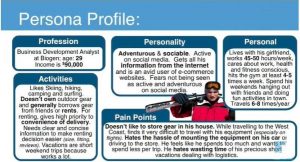Why use customer personas? After going through the process of identifying and segmenting a market, picking a beachhead market, calculating that it’s the right size, validating that the market will actually buy our product or service through primary market research, the next step is to look at the persona within the end user group. We have a strong indication that this group of end users has pain and urgency to buy our product or service.
What is a persona? A persona is a real-life person. What we want is a real person. Why? Because we want somebody that we can talk to; that represents the end-user group. Someone that we can use to iterate or improve the features, functions, and benefits of our product or service.
Now, the more expensive your product or service becomes, the more important that persona is. If you’re selling a $10 baseball cap, you know the persona, but it’s still nice to talk with people. If you’re selling a $10,000 piece of equipment or something that’s very expensive, having actual people is very important.
Why use customer personas? With the persona, you can validate many things in your business; the value proposition is one and the product or service.
The whole process of picking a persona can also align your team internally to who is the customer, it’s this person, and we all know them. We can go talk to them if we have a question about a service, we want to add or something we’re going to change within the model.
We can go ask them what they think, it’s very important to have that persona.
Anti-persona
Is there such a thing as an anti-persona? What would an anti-persona be for a training business? Maybe somebody who thinks that they know all the answers, somebody who is not teachable or is not a very good learner, or somebody that just wants to take up all the time and keep talking.
There’s an anti persona for your business, just like there’s a persona. If you have been in business, you know that a very small percent of your customers cause most of your problems. There’s a small group that you can’t please, it doesn’t matter what you do; they’re not going to be happy.
You’re never going to have complete satisfaction with that group. Wouldn’t it be nice if you could identify them ahead of time and not take them on as a customer? Identifying an anti-persona is also a very important step as you’re trying to select the persona for your organization.
Now we’ve got the end user group, we’ve picked a persona, and we know kind of who to avoid the people that are going to take up our time asking 1000 questions and never really buy our product. We want to identify those anti-personas so that we don’t waste our resources. This persona, again, is somebody very specific.
Find below an example of a customer persona for Bentrix, a company that hires out skiing and snowboarding equipment.

Next 10 Customers
In addition to the persona, we want to look at your next 10 customers. With the next 10 customers, here’s the question.
-
Sanity check
It is a sanity check to see if you’re in the right market with the end user group. If you can’t identify 10 more customers, are you in the right market to sell your product?
-
Validate market
We want to validate that we’re in the right market, and having more customers within that market helps us validate that we’re on the right track.
-
Similar solution
Are they looking for a similar solution?
-
Word of mouth
Do they talk to one another? Remember that all-important word of mouth.
The purpose of identifying the next 10 customers is really to validate we’re in the right market, we’re in the right end user group. We can now identify who else we’re going to sell the product or the service to.
When you have domain expertise, it’s not uncommon to bypass steps of the process of identifying a persona because you think you already know the answer. You can’t forget, you’re not the customer. Don’t try to second guess the market. Go ask the market.
That’s why we do primary market research. Do they have pain and urgency? Try to narrow down to the Beachhead market. Once you’ve narrowed down the beachhead, can you define some characteristics of the people who have pain, and are willing to pay for a solution?
You have to go out and conduct 50 to 100 interviews on the group that you select. When you figure out who the group is, maybe make some phone calls and ask some open-ended questions, don’t tell them what you’re selling. Just see if they have a problem.
Why use customer personas? You want to validate your market and end user and identify that persona’s next 10 customers when you’re doing your interviews.
Conclusion
Why use customer personas? It is important to use a real person for you to validate your value proposition. It also helps you to iterate the features, functions, and benefits of your product or service.

